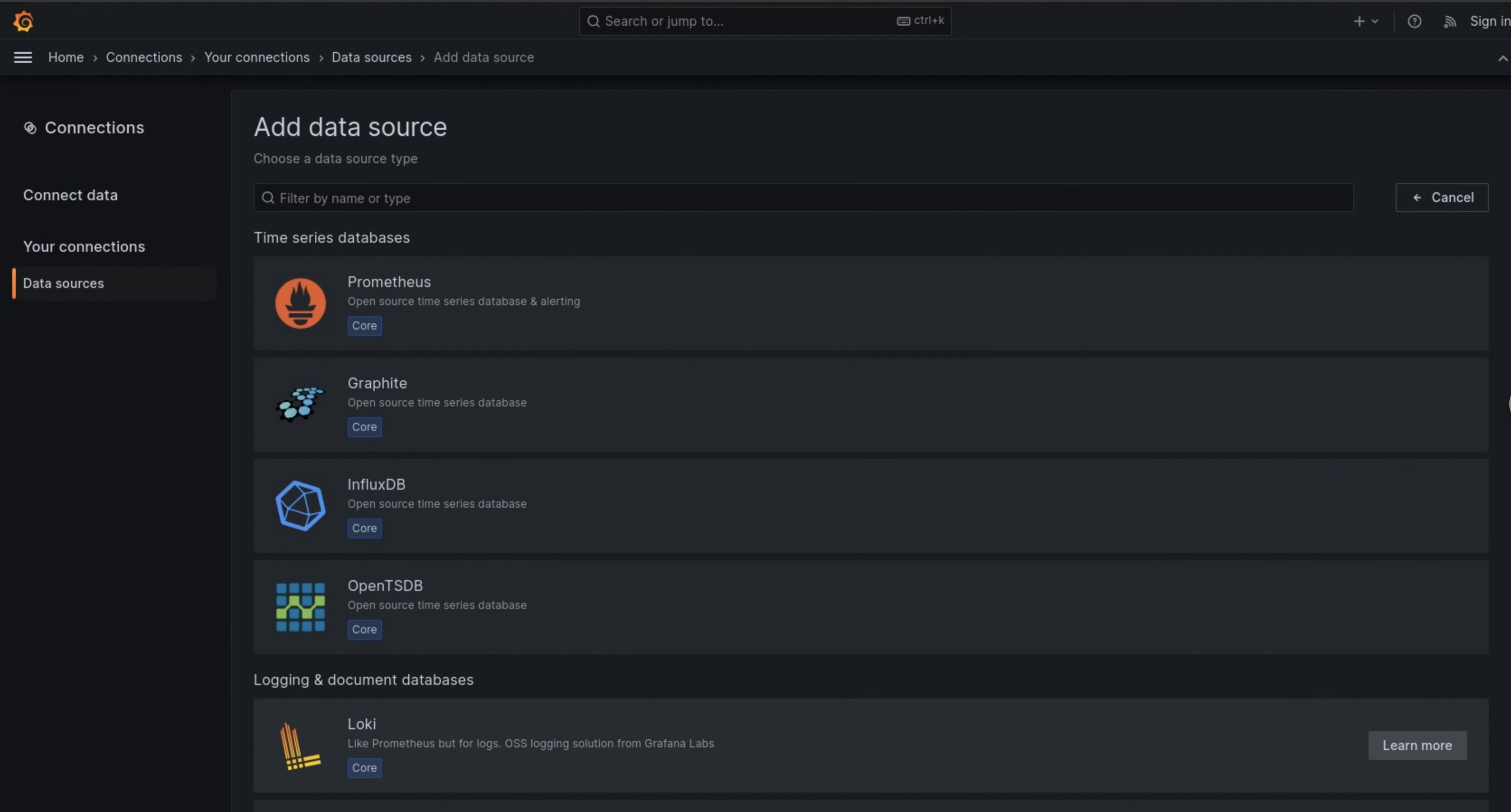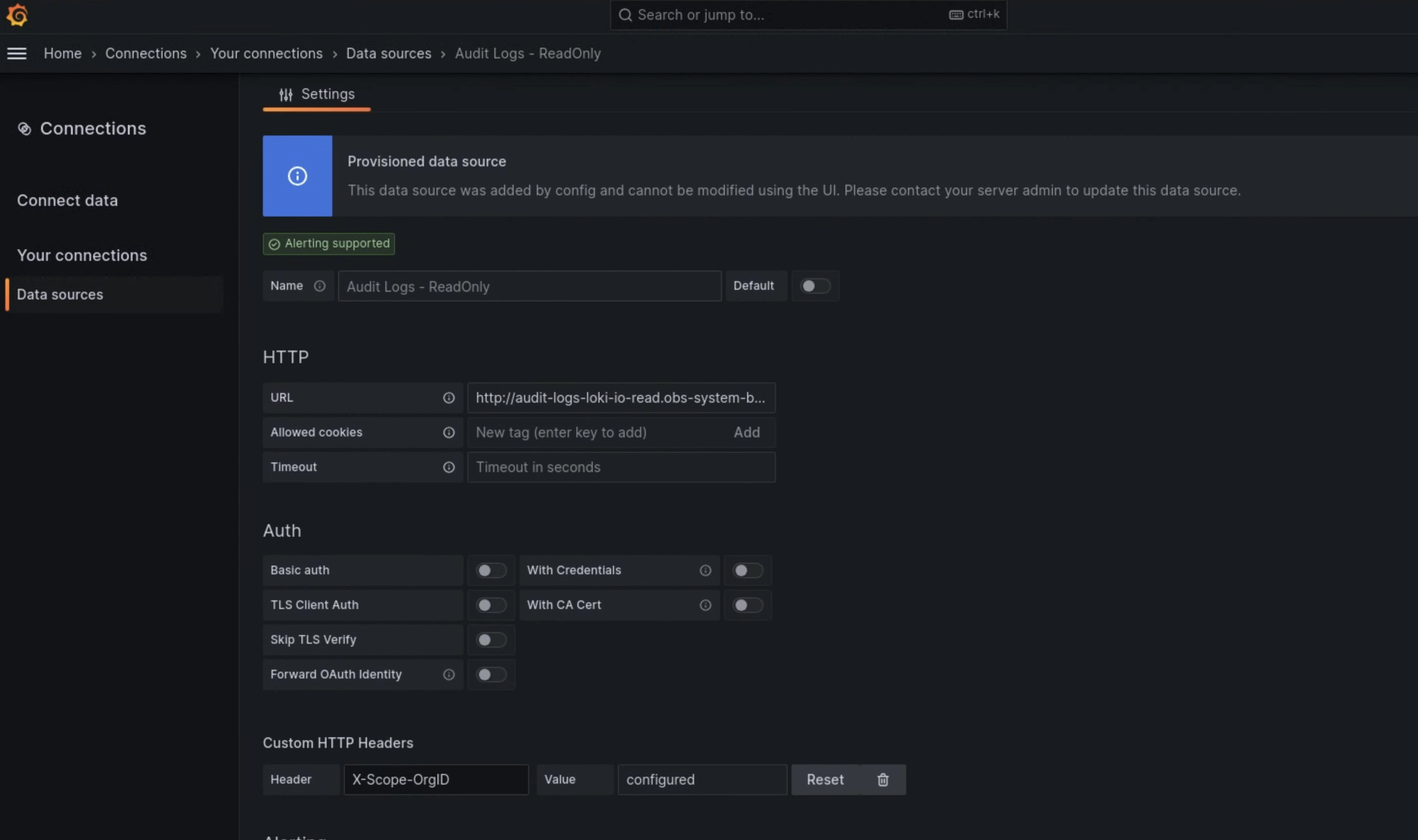This page describes how to secure audit logs from your Google Distributed Cloud (GDC) air-gapped appliance environment in remote backup buckets to preserve and restore data when necessary. The process includes steps for installing and configuring necessary components to recover historical audit logs from those backups.
Backups ensure that audit logs are preserved even if the original data is lost or corrupted, helping meet requirements and letting you recover information in case of system failures or accidental deletions. Restored audit logs provide access to historical data, enabling analysis of past events, security incidents, and user activity.
Implementing a backup and restore process for audit logs is beneficial for maintaining data integrity, ensuring compliance, and enabling historical analysis.
Before you begin
Ensure you have access to the following resources:
- A remote bucket for backups with an endpoint, secret access key, and access key ID.
- A certificate authority (CA) certificate for the storage system.
- A working Kubernetes cluster.
To get the permissions that you need to manage backups, ask your Project IAM Admin to grant you one of the following roles in your project namespace:
- Audit Logs Platform Restore Bucket Creator
- Audit Logs Platform Bucket Viewer
Depending on the level of access and permissions you need, you might obtain creator or viewer roles for backup bucket resources in your project namespace. For more information about these roles, see Prepare IAM permissions.
Set environment variables: Set the following environment variables to run the commands from this page:
* The path of the kubeconfig file:
```sh
export KUBECONFIG=KUBECONFIG_PATH
```
Replace `KUBECONFIG_PATH` with the path to the
kubeconfig file for the Management API server.
* Your project namespace:
```sh
export PROJECT_NAMESPACE=PROJECT_NAMESPACE
```
Secure audit logs in a backup
This section contains the steps to create a backup for audit logs in a remote bucket.
Set bucket credentials
You must set the access credentials for the following buckets:
- Source bucket: the local GDC bucket that contains the original audit logs you want to secure.
- Destination bucket: the remote bucket where you want to create the backup for audit logs.
Set the credentials for both buckets:
Source bucket
List the buckets in your project namespace from the Management API server:
kubectl --kubeconfig=${KUBECONFIG} get bucket -n ${PROJECT_NAMESPACE}The
DESCRIPTIONfield on the output indicates which buckets contain audit logs. Select the bucket that contains the logs you want to secure.According to the information from the output, set the following environment variables:
SRC_BUCKET= BUCKET_NAME SRC_ENDPOINT = ENDPOINT SRC_PATH= FULLY_QUALIFIED_BUCKET_NAMEReplace the following:
BUCKET_NAME: theBUCKET NAMEvalue of the output.ENDPOINT: theENDPOINTvalue of the output.FULLY_QUALIFIED_BUCKET_NAME: theFULLY-QUALIFIED-BUCKET-NAMEvalue of the output.
Get the bucket secret name:
kubectl get secret -n PROJECT_NAMESPACE -o json| jq --arg jq_src $SRC_BUCKET '.items[].metadata|select(.annotations."object.gdc.goog/subject"==$jq_src)|.name'Set the credentials variable:
SRC_CREDENTIALS="PROJECT_NAMESPACE/SECRET_NAME"Replace
SECRET_NAMEwith the secret name you obtained.Create the CA certificate secret:
kubectl create secret generic -n PROJECT_NAMESPACE audit-log-loki-ca \ --from-literal=ca.crt=CERTIFICATEReplace
CERTIFICATEwith the CA certificate of the storage system.Set the CA certificate variable:
SRC_CA_CERTIFICATE=PROJECT_NAMESPACE/audit-log-loki-ca
Destination bucket
Set the following environment variables for the remote destination bucket:
DST_ACCESS_KEY_ID= ACCESS_KEY DST_SECRET_ACCESS_KEY= ACCESS_SECRET DST_ENDPOINT= REMOTE_ENDPOINT DST_PATH= REMOTE_BUCKET_NAMEReplace the following:
ACCESS_KEY: the access key of the bucket.ACCESS_SECRET: the access secret of the bucket.REMOTE_ENDPOINT: the endpoint of the bucket.REMOTE_BUCKET_NAME: the name of the bucket.
Create a remote bucket secret:
kubectl create secret generic -n PROJECT_NAMESPACE s3-bucket-credentials \ --from-literal=access-key-id=$DST_ACCESS_KEY_ID \ --from-literal=secret-access-key=$DST_SECRET_ACCESS_KEYReplace
PROJECT_NAMESPACEwith your project namespace.Set the credentials variable:
DST_CREDENTIALS=PROJECT_NAMESPACE/s3-bucket-credentialsIf required, create a secret with the CA certificate of the bucket and set the CA certificate variable:
kubectl create secret generic -n PROJECT_NAMESPACE s3-bucket-ca \ --from-literal=ca.crt=REMOTE_CERTIFICATEReplace
REMOTE_CERTIFICATEwith the CA certificate of the destination bucket.Set the CA certificate variable:
DST_CA_CERTIFICATE=PROJECT_NAMESPACE/s3-bucket-ca
Transfer audit logs
Your Infrastructure Operator (IO) must create a transfer job for you to export
audit logs from the source bucket to the destination bucket for the backup. The
IO uses the preconfigured audit-log-pa-backup-restore-sa service account to
configure the transfer service for predefined buckets of platform audit logs.
Use the following job to transfer audit logs:
apiVersion: batch/v1
kind: Job
metadata:
name: audit-log-transfer-job
namespace: PROJECT_NAMESPACE
spec:
template:
spec:
serviceAccountName: audit-log-pa-backup-restore-sa
containers:
- name: storage-transfer-pod
image: gcr.io/private-cloud-staging/storage-transfer:latest
imagePullPolicy: Always
command:
- /storage-transfer
args:
- '--src_endpoint=$SRC_ENDPOINT
- '--dst_endpoint=$DST_ENDPOINT
- '--src_path=\$SRC_PATH
- '--dst_path=\$DST_PATH
- '--src_credentials=$SRC_CREDENTIALS
- '--dst_credentials=$DST_CREDENTIALS
- '--dst_ca_certificate_reference=$DST_CA_CERTIFICATE # Optional. Based on destination type.
- '--src_ca_certificate_reference=$SRC_CA_CERTIFICATE
- '--src_type=s3'
- '--dst_type=s3'
- '--bandwidth_limit=100M' # Optional of the form '10K', '100M', '1G' bytes per second
restartPolicy: OnFailure # Will restart on failure.
Monitor the data transfer
using the job name (audit-log-transfer-job) and your project namespace.
The job ends when all the data is transferred to the destination bucket.
Restore audit logs from a backup
This section contains the steps to restore audit logs from a backup in a remote bucket.
Create a bucket for restored logs
Create a bucket to store the restored audit logs:
Create the restore bucket:
apiVersion: object.gdc.goog/v1 kind: Bucket metadata: annotations: object.gdc.goog/audit-logs: PA labels: logging.private.gdch.goog/loggingpipeline-name: default name: audit-logs-loki-restore-pa namespace: PROJECT_NAMESPACE spec: bucketPolicy: lockingPolicy: defaultObjectRetentionDays: 1 description: Bucket for storing audit-logs-loki logs restore storageClass: StandardReplace
PROJECT_NAMESPACEwith your project namespace.View the bucket:
kubectl get bucket audit-logs-loki-restore-pa -n PROJECT_NAMESPACEThe creation of the bucket might take a few minutes.
According to the information from the output, set the following environment variables:
DST_BUCKET= RESTORE_BUCKET_NAME DST_ENDPOINT = RESTORE_ENDPOINT DST_PATH= RESTORE_FULLY_QUALIFIED_BUCKET_NAMEReplace the following:
RESTORE_BUCKET_NAME: theBUCKET NAMEvalue of the output.RESTORE_ENDPOINT: theENDPOINTvalue of the output.RESTORE_FULLY_QUALIFIED_BUCKET_NAME: theFULLY-QUALIFIED-BUCKET-NAMEvalue of the output.
Get the bucket secret name:
kubectl get secret -n PROJECT_NAMESPACE -o json| jq --arg jq_src $DST_BUCKET '.items[].metadata|select(.annotations."object.gdc.goog/subject"==$jq_src)|.name'Set the credentials variables:
DST_SECRET_NAME=RESTORE_SECRET_NAME DST_CREDENTIALS="PROJECT_NAMESPACE/RESTORE_SECRET_NAME"Replace
RESTORE_SECRET_NAMEwith the secret name you obtained.Create the CA certificate secret:
kubectl create secret generic -n PROJECT_NAMESPACE audit-log-loki-restore-ca \ --from-literal=ca.crt=CERTIFICATEReplace
CERTIFICATEwith the CA certificate of the storage system.Set the CA certificate variable:
DST_CA_CERTIFICATE=PROJECT_NAMESPACE/audit-log-loki-restore-ca
Set source bucket credentials
Set the credentials of the bucket that contains the backup for audit logs:
Set the following environment variables:
SRC_ACCESS_KEY_ID= ACCESS_KEY SRC_SECRET_ACCESS_KEY= ACCESS_SECRET SRC_ENDPOINT= REMOTE_ENDPOINT SRC_PATH= REMOTE_BUCKET_NAMEReplace the following:
ACCESS_KEY: the access key of the backup bucket.ACCESS_SECRET: the access secret of the backup bucket.REMOTE_ENDPOINT: the endpoint of the backup bucket.REMOTE_BUCKET_NAME: the name of the backup bucket.
Create a backup bucket secret:
kubectl create secret generic -n PROJECT_NAMESPACE s3-backup-bucket-credentials \ --from-literal=access-key-id=$SRC_ACCESS_KEY_ID \ --from-literal=secret-access-key=$SRC_SECRET_ACCESS_KEYSet the credentials variable:
SRC_CREDENTIALS=PROJECT_NAMESPACE/s3-backup-bucket-credentialsCreate a secret with the CA certificate of the bucket:
kubectl create secret generic -n PROJECT_NAMESPACE s3-backup-bucket-ca \ --from-literal=ca.crt=BACKUP_CERTIFICATEReplace
BACKUP_CERTIFICATEwith the CA certificate of the backup bucket.Set the CA certificate variable:
SRC_CA_CERTIFICATE=PROJECT_NAMESPACE/s3-backup-bucket-ca
Transfer restored audit logs
Your Infrastructure Operator (IO) must create a transfer job for you to restore
audit logs from the backup bucket to the restoration bucket. The
IO uses the preconfigured audit-log-pa-backup-restore-sa service account to
configure the transfer service for predefined buckets of platform audit logs.
Use the following job to transfer audit logs:
apiVersion: batch/v1
kind: Job
metadata:
name: audit-log-restore-job
namespace: PROJECT_NAMESPACE
spec:
template:
spec:
serviceAccountName: audit-log-pa-backup-restore-sa
containers:
- name: storage-transfer-pod
image: gcr.io/private-cloud-staging/storage-transfer:latest
imagePullPolicy: Always
command:
- /storage-transfer
args:
- '--src_endpoint=$SRC_ENDPOINT
- '--dst_endpoint=$DST_ENDPOINT
- '--src_path=\$SRC_PATH
- '--dst_path=\$DST_PATH
- '--src_credentials=$SRC_CREDENTIALS
- '--dst_credentials=$DST_CREDENTIALS
- '--dst_ca_certificate_reference=$DST_CA_CERTIFICATE
- '--src_ca_certificate_reference=$SRC_CA_CERTIFICATE # Optional. Based on destination type
- '--src_type=s3'
- '--dst_type=s3'
- '--bandwidth_limit=100M' # Optional of the form '10K', '100M', '1G' bytes per second
restartPolicy: OnFailure # Will restart on failure.
Monitor the data transfer
using the job name (audit-log-restore-job) and your project namespace.
The job ends when all the data is transferred to the restoration bucket.
Access restored logs
Deploy a Loki instance to access the restored logs using the provided configuration and deployment manifests:
Create a
ConfigMapobject for the configuration of the instance.The following is an example of a
ConfigMapobject:apiVersion: v1 kind: ConfigMap metadata: name: audit-logs-loki-restore-pa namespace: PROJECT_NAMESPACE data: loki.yaml: |- auth_enabled: true common: ring: kvstore: store: inmemory chunk_store_config: max_look_back_period: 0s compactor: shared_store: s3 working_directory: /data/loki/boltdb-shipper-compactor compaction_interval: 10m retention_enabled: true retention_delete_delay: 2h retention_delete_worker_count: 150 ingester: chunk_target_size: 1572864 chunk_encoding: snappy max_chunk_age: 2h chunk_idle_period: 90m chunk_retain_period: 30s autoforget_unhealthy: true lifecycler: ring: kvstore: store: inmemory replication_factor: 1 heartbeat_timeout: 10m max_transfer_retries: 0 wal: enabled: true flush_on_shutdown: true dir: /wal checkpoint_duration: 1m replay_memory_ceiling: 20GB limits_config: retention_period: 48h enforce_metric_name: false reject_old_samples: false ingestion_rate_mb: 256 ingestion_burst_size_mb: 256 max_streams_per_user: 20000 max_global_streams_per_user: 20000 per_stream_rate_limit: 256MB per_stream_rate_limit_burst: 256MB shard_streams: enabled: false desired_rate: 3MB schema_config: configs: - from: "2020-10-24" index: period: 24h prefix: index_ object_store: s3 schema: v11 store: boltdb-shipper server: http_listen_port: 3100 grpc_server_max_recv_msg_size: 104857600 grpc_server_max_send_msg_size: 104857600 analytics: reporting_enabled: false storage_config: boltdb_shipper: active_index_directory: /data/loki/boltdb-shipper-active cache_location: /data/loki/boltdb-shipper-cache cache_ttl: 24h shared_store: s3 aws: endpoint: $DST_ENDPOINT bucketnames: $DST_PATH access_key_id: ${S3_ACCESS_KEY_ID} secret_access_key: ${S3_SECRET_ACCESS_KEY} s3forcepathstyle: trueDeploy the instance as a
StatefulSetobject with aServicefor accessing logs.The following is an example of
StatefulSetandServiceobjects:apiVersion: apps/v1 kind: StatefulSet metadata: labels: app: audit-logs-loki-restore-pa logging.private.gdch.goog/loggingpipeline-name: default name: audit-logs-loki-restore-pa namespace: PROJECT_NAMESPACE spec: persistentVolumeClaimRetentionPolicy: whenDeleted: Retain whenScaled: Retain podManagementPolicy: OrderedReady replicas: 1 revisionHistoryLimit: 10 selector: matchLabels: app: audit-logs-loki-restore-pa serviceName: audit-logs-loki-restore-pa template: metadata: labels: app: audit-logs-loki-restore-pa app.kubernetes.io/part-of: audit-logs-loki-restore-pa egress.networking.gke.io/enabled: "true" istio.io/rev: default logging.private.gdch.goog/log-type: audit spec: affinity: nodeAffinity: preferredDuringSchedulingIgnoredDuringExecution: - preference: matchExpressions: - key: node-role.kubernetes.io/control-plane operator: DoesNotExist - key: node-role.kubernetes.io/master operator: DoesNotExist weight: 1 podAntiAffinity: preferredDuringSchedulingIgnoredDuringExecution: - podAffinityTerm: labelSelector: matchExpressions: - key: app operator: In values: - audit-logs-loki-restore-pa topologyKey: kubernetes.io/hostname weight: 100 containers: - args: - -config.file=/etc/loki/loki.yaml - -config.expand-env=true - -target=all env: - name: S3_ACCESS_KEY_ID valueFrom: secretKeyRef: key: access-key-id name: $DST_SECRET_NAME optional: false - name: S3_SECRET_ACCESS_KEY valueFrom: secretKeyRef: key: secret-access-key name: $DST_SECRET_NAME optional: false image: gcr.io/private-cloud-staging/loki:v2.8.4-gke.2 imagePullPolicy: Always livenessProbe: failureThreshold: 3 httpGet: path: /ready port: http-metrics scheme: HTTP initialDelaySeconds: 330 periodSeconds: 10 successThreshold: 1 timeoutSeconds: 1 name: audit-logs-loki-restore-pa ports: - containerPort: 3100 name: http-metrics protocol: TCP - containerPort: 7946 name: gossip-ring protocol: TCP readinessProbe: failureThreshold: 3 httpGet: path: /ready port: http-metrics scheme: HTTP initialDelaySeconds: 45 periodSeconds: 10 successThreshold: 1 timeoutSeconds: 1 resources: limits: ephemeral-storage: 2000Mi memory: 8000Mi requests: cpu: 300m ephemeral-storage: 2000Mi memory: 1000Mi securityContext: readOnlyRootFilesystem: true terminationMessagePath: /dev/termination-log terminationMessagePolicy: File volumeMounts: - mountPath: /etc/loki name: config - mountPath: /data name: loki-storage - mountPath: /tmp name: temp - mountPath: /tmp/loki/rules-temp name: tmprulepath - mountPath: /etc/ssl/certs/storage-cert.crt name: storage-cert subPath: ca.crt - mountPath: /wal name: loki-storage dnsPolicy: ClusterFirst priorityClassName: audit-logs-loki-priority restartPolicy: Always schedulerName: default-scheduler securityContext: fsGroup: 10001 runAsGroup: 10001 runAsUser: 10001 serviceAccount: audit-log-pa-backup-restore-sa serviceAccountName: audit-log-pa-backup-restore-sa terminationGracePeriodSeconds: 4800 volumes: - emptyDir: {} name: temp - configMap: defaultMode: 420 name: audit-logs-loki-restore-pa name: config - emptyDir: {} name: tmprulepath - name: storage-cert secret: defaultMode: 420 secretName: web-tls updateStrategy: type: RollingUpdate volumeClaimTemplates: - apiVersion: v1 kind: PersistentVolumeClaim metadata: creationTimestamp: null name: loki-storage spec: accessModes: - ReadWriteOnce resources: requests: storage: 50Gi storageClassName: standard-rwo volumeMode: Filesystem --- apiVersion: v1 kind: Service metadata: name: audit-logs-loki-restore-pa namespace: PROJECT_NAMESPACE spec: internalTrafficPolicy: Cluster ipFamilies: - IPv4 ipFamilyPolicy: SingleStack ports: - name: http-metrics port: 3100 protocol: TCP targetPort: http-metrics selector: app: audit-logs-loki-restore-pa sessionAffinity: None type: ClusterIP
View restored logs
Configure Grafana to view the restored audit logs from the Loki instance:
- Open the Grafana endpoint of your project. For more information, see Query and view logs.
- From the navigation menu of the user interface, click Administration > Data sources.
- Click Add new data source.
- On the Add data source page, select Loki.
- On the Settings page, enter
Audit Logs - Restorein the Name field. On the HTTP section, enter the following value in the URL field:
http://audit-logs-loki-restore-pa.PROJECT_NAMESPACE.svc:3100On the Custom HTTP Headers section, enter the following values in the corresponding fields:
- Header:
X-Scope-OrgID - Value:
infra-obs
- Header:
In figure 1, Loki is displayed as an option on the Add data source page.

Figure 1. The Add data source page on the UI of the monitoring instance.

Figure 2. The Settings page on the UI of the monitoring instance.
The Audit Logs - Restore option is now available as a data source in the log explorer.
